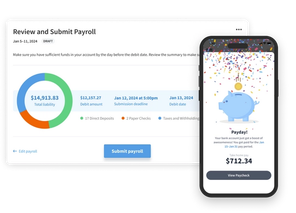
Eddy’s HR Mavericks Encyclopedia
The world's largest free encyclopedia of HR, with 700+ HR articles and podcasts.
Created by Eddy and our HR Mavericks community.
Payroll Statistics
Payroll is an incredibly complex area of HR—getting it wrong can have serious financial costs and impact a company’s credibility greatly. This article brings together important payroll statistics from a variety of sources that illustrate everything from the impact of payroll errors to how payroll procedures are changing.Read on to discover what our research can tell you about payroll trends and worker expectations, as well as important statistics to consider if you are thinking about changing your payroll practices.
Payroll is an incredibly complex area of HR—getting it wrong can have serious financial costs and impact a company’s credibility greatly. This article brings together important payroll statistics from a variety of sources that illustrate everything from the impact of payroll errors to how payroll procedures are changing.Read on to discover what our research can tell you about payroll trends and worker expectations, as well as important statistics to consider if you are thinking about changing your payroll practices.
How to Get Payroll Right
The statistics make it clear: payroll is an essential part of running a business, large or small, but it can also be time-consuming and costly. If you’re just getting started with payroll, here are a few things you can do to streamline the process and avoid expensive errors. Click the links to learn more!
- Understand payroll deductions. Payroll deductions are withheld from your workers’ gross pay, and they take home what’s left over. Involuntary deductions are required by law—one example is income tax. Voluntary deductions, such as 401(k) contributions, are up to the employee.
- Classify workers correctly. When hiring full-time or part-time employees, you must classify them as FLSA exempt (not entitled to overtime pay) or FLSA non-exempt (entitled to overtime pay). Misclassifying an employee can lead to serious consequences, including fines.
- Know the difference between contractors and employees. Recently, the IRS has created more guidelines around how independent contractors are defined. In this growing gig economy, you’ll face hefty penalties if you wrongly classify employees as contractors.
- Be aware of common payroll mistakes. It’s easier to avoid making payroll mistakes if you know what the most common ones are.
Ditch manual payroll processes. Eddy provides a better payroll solution for small businesses. With integrated time and PTO tracking, automated tax filings, and more, Eddy makes payroll simple. We do the heavy lifting so you don’t have to. Find out if Eddy Payroll is right for your business.
Topics

Eddy
Eddy is the all-in-one HR tool built with you in mind. The robust features and ease of use will benefit your company both inside and outside your HR team.
Other Related Terms
Eddy’s HR Mavericks Encyclopedia
Payroll Statistics
Payroll is an incredibly complex area of HR—getting it wrong can have serious financial costs and impact a company’s credibility greatly. This article brings together important payroll statistics from a variety of sources that illustrate everything from the impact of payroll errors to how payroll procedures are changing.Read on to discover what our research can tell you about payroll trends and worker expectations, as well as important statistics to consider if you are thinking about changing your payroll practices.
Payroll is an incredibly complex area of HR—getting it wrong can have serious financial costs and impact a company’s credibility greatly. This article brings together important payroll statistics from a variety of sources that illustrate everything from the impact of payroll errors to how payroll procedures are changing.Read on to discover what our research can tell you about payroll trends and worker expectations, as well as important statistics to consider if you are thinking about changing your payroll practices.
How to Get Payroll Right
The statistics make it clear: payroll is an essential part of running a business, large or small, but it can also be time-consuming and costly. If you’re just getting started with payroll, here are a few things you can do to streamline the process and avoid expensive errors. Click the links to learn more!
- Understand payroll deductions. Payroll deductions are withheld from your workers’ gross pay, and they take home what’s left over. Involuntary deductions are required by law—one example is income tax. Voluntary deductions, such as 401(k) contributions, are up to the employee.
- Classify workers correctly. When hiring full-time or part-time employees, you must classify them as FLSA exempt (not entitled to overtime pay) or FLSA non-exempt (entitled to overtime pay). Misclassifying an employee can lead to serious consequences, including fines.
- Know the difference between contractors and employees. Recently, the IRS has created more guidelines around how independent contractors are defined. In this growing gig economy, you’ll face hefty penalties if you wrongly classify employees as contractors.
- Be aware of common payroll mistakes. It’s easier to avoid making payroll mistakes if you know what the most common ones are.
Ditch manual payroll processes. Eddy provides a better payroll solution for small businesses. With integrated time and PTO tracking, automated tax filings, and more, Eddy makes payroll simple. We do the heavy lifting so you don’t have to. Find out if Eddy Payroll is right for your business.
Topics

Eddy
Eddy is the all-in-one HR tool built with you in mind. The robust features and ease of use will benefit your company both inside and outside your HR team.
Other Related Terms
Eddy's HR Newsletter
Sign up for our email newsletter for helpful HR advice and ideas.


